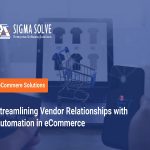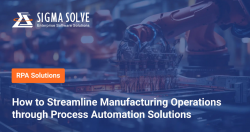AI-Based Dynamic Pricing: Real-time Revenue Optimization
Businesses often disappear in the perplexity of pricing regardless of the competitive marketplace. The paradigm shift is brought about as AI is introduced, like a Jedi Master of dynamic pricing. Alpesh Sarvaiya, VP of Engineering at Sigma Solve Inc., mystically and succulently explains the role of AI in dynamic pricing and how businesses can leverage AI to improve profitability. AI cuts through the pricing chaos through dynamic pricing solutions to drive businesses toward a cornucopia of revenue with the precision and foresight of AI.
Synopsis:
For businesses going global, relying on gut feelings is less attractive than receiving AI development services with open arms for dynamic pricing to maximize revenue generation and profitability without switching to the darker sides.
This blog explores the role of artificial intelligence in dynamic pricing and how AI leverages machine learning algorithms for data analytics in real-time to fix product prices dynamically and delightfully (unlike the text habits of your ex). This blog explains how businesses can forget the age-old pricing strategies for dynamic pricing strategies and embrace AI to read customers’ and competitors’ minds, make lightning-fast decisions on pricing, and boost sales.
What is AI-powered Dynamic Pricing?
Assume that Apple displays Apple 15 Max Pro with a different price tag to you and less to your friend or two different prices at two different times. These changes in the price of the product based on time, day, customer type, buying intent, and market trends are known as dynamic prices. Artificial intelligence is responsible for these changes, independently changing product prices based on real-time data analytics.
AI-based pricing use machine learning algorithms to analyze the large volume of data emanating from customer behavior on eCommerce platforms, oscillating marketing trends, production, supply chain, inventory levels, and external factors, such as interest rates, raw material prices, and government policies.
How AI Transforms Dynamic Pricing?
Have you ever seen a workaholic? A workaholic in the finance industry works for 18 hours a day. AI dynamic pricing solutions batter such workaholics by analyzing large volumes of data round the clock, providing real-time insights into various business aspects to determine product dynamic prices.
Machine learning algorithms constantly monitor customers’ buying habits, social media trends, competitors’ strategies, and many other data points. This comprehensive data analytics allows businesses to strategize dynamic product pricing that results in profitability.
Customer Behavior:
From browsers to online stores, AI tracks customers’ behavior through browsing patterns, product surfing, shopping history, and the data they have provided to predict their future needs, preferences, and buying probability.
Market Trends:
Artificial intelligence evaluates various data, including demand and supply, raw material prices, production capacity, interest rates, and global economic factors, to predict market movements and dynamically price products.
Inventory Levels:
AI-based pricing solutions consider the production cycle, raw material availability, logistics costs, stock clearance time, and regulatory compliance. Effective inventory management determines dynamic prices.
External Factors:
Nowadays, AI considers broader aspects, such as government policy, the effects of climate change, future events, holiday seasons, and socio-economic sentiments of society, to adjust product prices.
The Benefits of AI-based Dynamic Pricing:
Those still have reservations about AI for dynamic pricing may find things a bit fancy. However, the benefits of dynamic pricing are real, and eCommerce businesses are upscaling their bottom line, expanding their revenue avenues, identifying customers willing to pay for value addition, and optimizing sales strategies.
Consequently, businesses are enhancing customer experiences and improving their ROI and profitability. Businesses utilize this data-based insight to evaluate future demand and determine its longevity, ultimately achieving a maximum price range. This dynamic price is translated into perfect alignment with the customer’s perception and value proposition.
Maximize revenue:
Automated tactical pricing ensures that businesses sell products with the best profit margins. Dynamic pricing solutions determine the sweet spot where customers and businesses can have a win-win situation.
Increase Profit Margins:
Dynamic pricing strategies consider the market trends and cost oscillation to determine the best product price at which customers see value addition, and businesses can broaden their profit margins.
Boost sales velocity:
Inventory clearance is as vital as profitability for businesses. AI-based pricing solutions help businesses recognize possibilities to strategically lower the price to generate demand and boost sales to reduce the burden of stocks.
Enhance customer experience:
Anything personalized would attract customers; if it’s personalized pricing, customers are more likely to buy. AI pricing solutions enhance customers’ value perception to boost customer loyalty, increasing sales and revenue.
How Does AI Make Dynamic Pricing Decisions?
Earlier, there was no concept of dynamic pricing. Businesses determine the price of products based on how competitors behave and what stocks they have. The product prices used to remain fixed for a long time. As AI entered the product pricing realm, the scenario changed dramatically.
Highly functional and trained ML algorithms are used in AI-powered dynamic pricing solutions to help businesses analyze data in real-time, around the clock, and rigorously. Businesses employ various techniques to implement dynamic pricing.
Regression Analysis:
The most potent technique is to analyze product prices and the factors affecting them daily. The method evaluates data from demand, shelf life, inventory, competition, market trends, etc. It correlates with pricing to predict the ideal price at a particular time, day, and week for a particular target audience.
Clustering:
AI-based pricing solutions create customer segments based on age groups, demography, buying patterns, product preferences, etc. This clustering is used to determine the price point for a particular cluster of customers. Automated tactical pricing is determined based on value perception.
Time Series Forecasting:
Think of having a fortune teller for pricing. This technique allows dynamic pricing solutions to analyze historical data and trends of demand patterns. Based on data analytics, future demand is predicted and implemented during the season or period. Prices are adjusted dynamically.
Reinforcement Learning:
This is a learn-and-perform technique in which machine learning algorithms continuously learn and enforce an AI system to change product prices in real-time. Algorithms analyze customers’ digital movements and responses to refine prices on the spot and optimize them for future events.
Factors Influencing AI-powered Dynamic Pricing:
One might think this is a vacuum in which these price dynamics function. Far from the fact, AI-powered dynamic pricing functions in deep connection with multiple factors. Machine learning algorithms consider many pricing aspects and analyze many factors before breaking them down into various elements influencing price dynamics. Dynamic pricing solutions can be tailored, denoting a value proposition to pricing.
Demand:
Demand is one influential element that inadvertently affects prices. If the product is in great demand, businesses tend to keep the prices high. Discounts are often offered for low demand. Therefore, demand determines the price.
Competition:
The price is determined by the competition it faces and the market behavior of the competitors. Either businesses can stay ahead, reducing their profitability, or can find a sweet spot to stay afloat.
Customer Segments:
Product prices are often determined by what kind of customer buys it. If the customer is loyal, a discount may be offered. But a high price can be set for the new customer, keeping profitability in mind,
Product Lifecycle:
AI can determine each product’s shelf life and price accordingly. Products with a long shelf life can have premium prices, and those with a low life can attract discounts to clear the stocks.
Inventory Levels
AI can see the product’s stocks and production capabilities to determine the price. If there is enough stock, the product may attract coupons. On the contrary, prices may go high if stocks are depleting fast.
Perceived Value:
If customers see the value in the product or need it urgently, they may end up paying more than one who has no urgency or sees less value in the product comparatively; value perception helps fix prices.
Considerations for Implementing AI-powered Dynamic Pricing:
Dynamic pricing solutions require a thoroughly thought-out strategy since one solution can’t be implemented across the segment or products. It is essential to factor in crucial influencing concepts before developing a strategy for AI-powered dynamic pricing.
Data Quality: For AI dynamic pricing solutions to work efficiently and consistently, businesses must invest in diverse and accurate data quality and management. Defining Goals: Revenue expansion, profitability, or stock clearance? Businesses must have clear goals behind strategizing and implementing AI-based dynamic pricing.
Transparency: Customers should be aware of dynamic pricing. Transparency in business strategies is critical to building and managing a brand’s reputation.
A/B Testing: AI models should be designed for continuous learning and refining performance to achieve the stated goals of implementing dynamic pricing.
Automation: AI-powered dynamic pricing should be part of the process automation solutions to align the entire system with objectives.
Ethical Considerations: AI development services providers should not be biased and discriminative. AI must be used for the common good.
Looking Ahead: The Future of Dynamic Pricing with AI:
An AI solution that improves profitability on the one hand and customer experience on the other is desirable. AI-powered dynamic pricing are the most potent weapon in the hands of businesses to expand their revenue base and enhance customer satisfaction. Let’s examine the future of dynamic prices with these four aspects.
Dynamic pricing solutions will adapt to hyper-personalization, offering individuals product pricing in real-time based on their habits, health, and shopping history.
Businesses will witness AI’s predictive analytics capabilities on steroids. AI will more accurately predict trends and patterns, helping businesses meet demands.
Brick-and-mortar characters will find AI support. AI dynamic pricing solutions will negotiate the price, discount, and cashback with customers in real time, evaluating personal data.
Transparency, reputation, reliability, and morality will be top business priorities as AI evolves. Ethical considerations will drive trust in brands.
Conclusion:
Jedi Master or not, AI influences human life like never before and will impact us with deeper penetration. Dynamic price solutions are an excellent way for businesses to improve their profitability. Simultaneously, they help businesses build trust among customers to build a loyal customer base and, on the other hand, enhance their experiences. AI uncovers more possibilities here in terms of data analytics and predictive analysis. Considering the inevitability of AI and dynamic pricing solutions, businesses must adopt them quickly and ethically for a better future. Being brainless is a bane; being brainfree is a boon.
Original Source: Here


















